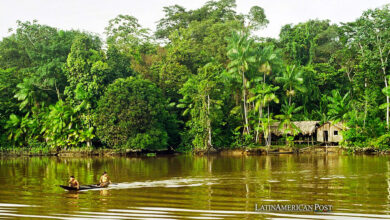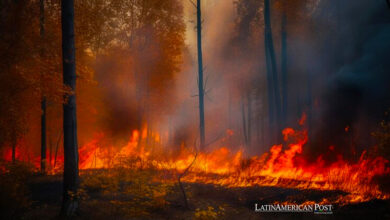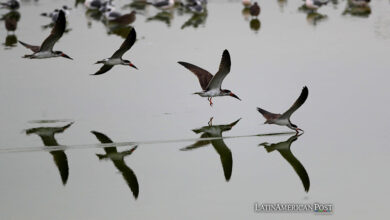Coyotes, a threat to South America
Deforestation has turned this animal into an invasive species that is very dangerous for biodiversity.

This species is consolidated as a threat to the biodiversity of South America. / Photo: Pixabay
LatinAmerican Post | Alberto Castano
Listen to this article
Leer en español: Los coyotes, una amenaza para Suramérica
The study carried out by several researchers led by the Colombian-Costa Rican José Fernando González-Maya PhD, on the invasive colonization of the American Coyote (Canis latrans) from North America to Central and possibly South America, was recently published in the scientific journal Integrative Zoology. It alarms the scientific community as it constitutes a serious threat against the rich biodiversity of South America.
Those canids that we all have in the cultural imaginative accompanying the caravans of settlers and cowboys through the deserts of the southern United States and Northern Mexico, naturally inhabit the three countries of North America, it is there where they find their traditional prey, habitats, and natural predators. However, man has managed to extend a gentle invitation to this species to penetrate ecosystems that traditionally are not its own, generating serious environmental damage.
González-Maya, director of the organization ProCAT assures that “although there are fossil records of coyotes in the Pleistocene, the species retreated to North America as a consequence of the post-glacial era and with the appearance of very dense tropical forests unfriendly to Coyote dynamics. "
However, the high rate of deforestation in countries such as southern Mexico, Guatemala, El Salvador, Honduras, Nicaragua, Costa Rica and Panama, has been an invitation to the coyote to penetrate these areas as they went from being tropical forests to large areas of crops or pastures dedicated to agriculture and livestock.
Also read: Countries must work together on CO2 removal to avoid dangerous climate change
Nature is perfect and when man alters it, there is no way that things will go right. One of the examples of the serious affectations is the decrease of a key species for the paramos of the Talamanca mountain range in Costa Rica. Those fragile ecosystems are the natural habitat of the Mountain Rabbit (Sylvilagus dicei).
The role of this rabbit endemic to the Tico country lies in that it is one of the largest consumers of vegetation, fulfilling several functions, one of which is the dispersal of seeds, but beyond that, they are a key link in the transfer of nutrients, matter, and energy throughout the food chain.
Not only this small animal is being threatened by the presence of an invasive animal such as the coyote, the cougar is also a victim of the arrival of these canids. The second-largest feline in America is also present in the high mountains and one of its usual prey is rabbits, but it hunts them at a much lower success rate than that of coyotes, therefore, a perfect balance is maintained between the number of prey and the number of predators. Balance that the coyote has come to tip dangerously.
In addition to this, coyotes are clearly more successful than cougars, as they hunt in packs, unlike the feline, which is a solitary hunter. This 'unfair competition' has generated a phenomenon that is known as competitive exclusion affecting the populations of the 'mountain lion'.
The drastic decrease in the populations of these two species taking them to the brink of disappearance generates a cascade of negative effects such as the impossibility of carbon fixation and water production threatening the disappearance of the paramo.
Despite the seriousness of the consequences that are already being seen in Central America, the greatest weight would be borne by South America if invaded by this colonizing species. From the Darien Gap to the southern cone of the continent. González-Maya assures that as there is a greater variety of prey in South America, in the same way there are a greater number of species of predators that could potentially be victims of competitive exclusion, just as the cougar is in Central America.
The only thing that stops the advance of the coyote are the thick forests of the Darién Gap on the border between Colombia and Panama, however, the existence of these is not an absolute guarantee of the impossibility that this successful species would have to invade the coffee country and then the rest of South America.
Also read: Volunteering: when gratification matters more than money
The panorama is highly worrisome, since in the Caribbean region of Colombia only 2% of the original tropical dry forest remains, according to figures from the Alexander Von Humboldt Institute of Research and Biological Resources, that is the same fate that forests in Central America suffered from the obvious results of colonization. This suggests the risk of a high threat to the present biodiversity, not only in that area, but also in the rest of the continent.
But the problems do not stop there. Thanks to the neglect of pets in rural areas in Colombia, the proliferation of packs of feral dogs has increased. There are some scientists who believe that hybridization between coyotes and dogs can occur constantly, further exacerbating the problem.
For his part, Ricardo Moreno, associate researcher of the Smithsonian Institute for Tropical Studies, president and researcher of the Fundación Yaguará Panamá, considers that the stable populations of jaguars in Darien can be a brake on the advance of the coyote, but if the rate of deforestation in this tropical humid forest continues to advance and the populations of jaguars in the area are affected, it can be taken for granted that the coyote will colonize South America in a few years.





